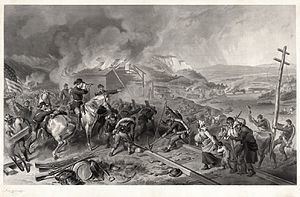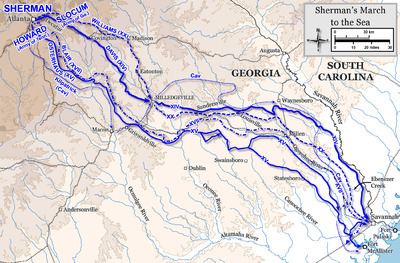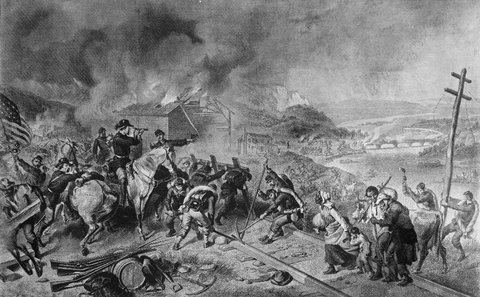59,545–62,204 12,466 | ||
 | ||
Similar American Civil War, Atlanta Campaign, Siege of Vicksburg, Battle of Appomattox Court Ho, Battle of Gettysburg | ||
Sherman s march to the sea
Sherman's March to the Sea, more formally known as the Savannah Campaign, was a military campaign of the American Civil War conducted through Georgia from November 15 to December 21, 1864 by Maj. Gen. William Tecumseh Sherman of the Union Army. The campaign began with Sherman's troops leaving the captured city of Atlanta, on November 15 and ended with the capture of the port of Savannah on December 21. His forces destroyed military targets as well as industry, infrastructure, and civilian property and disrupted the Confederacy's economy and its transportation networks. Sherman's bold move of operating deep within enemy territory and without supply lines is considered to be one of the major achievements of the war.
Contents
- Sherman s march to the sea
- The conquerors sherman s march to the sea
- Military situation
- Union
- Confederate
- March
- Aftermath
- Legacy
- References

The conquerors sherman s march to the sea
Military situation

Sherman's "March to the Sea" followed his successful Atlanta Campaign of May to September 1864. He and the Union Army's commander, Lt. Gen. Ulysses S. Grant, believed that the Civil War would come to an end only if the Confederacy's strategic, economic, and psychological capacity for warfare were decisively broken. Sherman therefore planned an operation that has been compared to the modern principles of scorched earth warfare, or total war. Although his formal orders (excerpted below) specified control over destruction of infrastructure in areas in which his army was unmolested by guerrilla activity, he recognized that supplying an army through liberal foraging would have a destructive effect on the morale of the civilian population it encountered in its wide sweep through the state.

The second objective of the campaign was more traditional. Grant's armies in Virginia continued in a stalemate against Robert E. Lee's army, besieged in Petersburg, Virginia. By moving in Lee's rear and performing a massive turning movement against him, Sherman could possibly increase pressure on Lee, allowing Grant the opportunity to break through, or at least keep Southern reinforcements away from Virginia.

The campaign was designed by Grant and Sherman to be similar to Grant's innovative and successful Vicksburg Campaign and Sherman's Meridian Campaign, in that Sherman's armies would reduce their need for traditional supply lines by "living off the land" after consuming their 20 days of rations. Foragers, known as "bummers", would provide food seized from local farms for the Army while they destroyed the railroads and the manufacturing and agricultural infrastructure of Georgia. In planning for the march, Sherman used livestock and crop production data from the 1860 census to lead his troops through areas where he believed they would be able to forage most effectively. The twisted and broken railroad rails that the troops heated over fires and wrapped around tree trunks and left behind became known as "Sherman's neckties". As the army would be out of touch with the North throughout the campaign, Sherman gave explicit orders, Sherman's Special Field Orders, No. 120, regarding the conduct of the campaign. The following is an excerpt from the general's orders:

The march was made easier by able assistants such as Orlando Poe, Chief of the bridge building and demolition team. Maj. Gen. William T. Sherman selected Poe as his chief engineer in 1864. Poe oversaw the burning of Atlanta, for which action he was honored by Sherman. Poe directly supervised the dismantling of all buildings and structures in Atlanta that could have provided any military value to the Rebels once Sherman abandoned the city; rail depots, roundhouses, arsenals and storage areas were manually disassembled and the combustible materials then destroyed by controlled fires (however, Poe was incensed at the level of uncontrolled arson by marauding soldiers not of his unit which resulted in heavy damage to civilian homes.) He served in this capacity past the fall of Atlanta to the end of the war. Dozens of river crossings, poor or non-existent roads and the extensive swamps of southern Georgia would have fatally slowed Sherman's force had not Poe's skills as leader of the bridge, road and pontoon building units kept the army moving. He also continued to supervise destruction of Confederate infrastructure. Promoted by Sherman by two steps in rank -to Colonel- after the fall of Savannah, he continued in that capacity in the war's concluding Carolinas Campaign as Sherman headed northwards from Savannah to link up with Grant and the Army of the Potomac in Virginia and to cut another swath through South and North Carolina.[
Union
Sherman, commanding the Military Division of the Mississippi, did not employ his entire army group in the campaign. Confederate Lt. Gen. John Bell Hood was threatening Sherman's supply line from Chattanooga, and Sherman detached two armies under Maj. Gen. George H. Thomas to deal with Hood in the Franklin-Nashville Campaign. For the Savannah Campaign, Sherman's remaining force of 62,000 men (55,000 infantry, 5,000 cavalry, and 2,000 artillerymen manning 64 guns) was divided into two columns for the march:
Confederate
The Confederate opposition from Lt. Gen. William J. Hardee's Department of South Carolina, Georgia, and Florida was meager. Hood had taken the bulk of forces in Georgia on his campaign to Tennessee in hopes of diverting Sherman to pursue him. Considering Sherman's military priorities however, this tactical maneuver by his enemy to get out of his force's path was welcomed to the point of remarking, "If he will go to the Ohio River, I'll give him rations." There were about 13,000 men remaining at Lovejoy's Station, south of Atlanta. Maj. Gen. Gustavus W. Smith's Georgia militia had about 3,050 soldiers, most of whom were boys and elderly men. The Cavalry Corps of Maj. Gen. Joseph Wheeler, reinforced by a brigade under Brig. Gen. William H. Jackson, had approximately 10,000 troopers. During the campaign, the Confederate War Department brought in additional men from Florida and the Carolinas, but they never were able to increase their effective force beyond 13,000.
March
Both U.S. President Abraham Lincoln and General Ulysses S. Grant had serious reservations about Sherman's plans. Still, Grant trusted Sherman's assessment and on November 2, 1864, he sent Sherman a telegram stating simply, "Go as you propose." The 300-mile (480 km) march began on November 15. Sherman recounted in his memoirs the scene when he left at 7 a.m. the following day:
Sherman's personal escort on the march was the 1st Alabama Cavalry Regiment, a unit made up entirely of Southerners who remained loyal to the Union.
The two wings of the army attempted to confuse and deceive the enemy about their destinations; the Confederates could not tell from the initial movements whether Sherman would march on Macon, Augusta, or Savannah. Howard's wing, led by Kilpatrick's cavalry, marched south along the railroad to Lovejoy's Station, which caused the defenders there to conduct a fighting retreat to Macon. The cavalry captured two Confederate guns at Lovejoy's Station, and then two more and 50 prisoners at Bear Creek Station. Howard's infantry marched through Jonesboro to Gordon, southwest of the state capital, Milledgeville. Slocum's wing, accompanied by Sherman, moved to the east, in the direction of Augusta. They destroyed the bridge across the Oconee River and then turned south.
The first real resistance was felt by Howard's right wing at the Battle of Griswoldville on November 22. Confederate Maj. Gen. Wheeler's cavalry struck Brig. Gen. Kilpatrick's, killing one, wounding two and capturing 18. The infantry brigade of Brig. Gen. Charles C. Walcutt arrived to stabilize the defense, and the division of Georgia militia launched several hours of badly coordinated attacks, eventually retreating with about 1,100 casualties (of which about 600 were prisoners), versus the Union's 100.
At the same time, Slocum's left wing approached the state capital at Milledgeville, prompting the hasty departure of Governor Joseph Brown and the state legislature. On November 23, Slocum's troops captured the city and held a mock legislative session in the capitol building, jokingly voting Georgia back into the Union.
Several small actions followed. Wheeler and some infantry struck in a rearguard action at Ball's Ferry on November 24 and November 25. While Howard's wing was delayed near Ball's Bluff, the 1st Alabama Cavalry (a Federal regiment) engaged Confederate pickets. Overnight, Union engineers constructed a bridge 2 miles (3.2 km) away from the bluff across the Oconee River, and 200 soldiers crossed to flank the Confederate position. On November 25–26 at Sandersville, Wheeler struck at Slocum's advance guard. Kilpatrick was ordered to make a feint toward Augusta before destroying the railroad bridge at Brier Creek and moving to liberate the Camp Lawton prisoner of war camp at Millen. Kilpatrick slipped by the defensive line that Wheeler had placed near Brier Creek, but on the night of November 26 Wheeler attacked and drove the 8th Indiana and 2nd Kentucky Cavalry away from their camps at Sylvan Grove. Kilpatrick abandoned his plans to destroy the railroad bridge and he also learned that the prisoners had been moved from Camp Lawton, so he rejoined the army at Louisville. At the Battle of Buck Head Creek on November 28, Kilpatrick was surprised and nearly captured, but the 5th Ohio Cavalry halted Wheeler's advance, and Wheeler was later stopped decisively by Union barricades at Reynolds's Plantation. On December 4, Kilpatrick's cavalry routed Wheeler's at the Battle of Waynesboro.
More Union troops entered the campaign from an unlikely direction. Maj. Gen. John G. Foster dispatched 5,500 men and 10 guns under Brig. Gen. John P. Hatch from Hilton Head, hoping to assist Sherman's arrival near Savannah by securing the Charleston and Savannah Railroad. At the Battle of Honey Hill on November 30, Hatch fought a vigorous battle against G.W. Smith's 1,500 Georgia militiamen, 3 miles (4.8 km) south of Grahamville Station, South Carolina. Smith's militia fought off the Union attacks, and Hatch withdrew after suffering about 650 casualties, versus Smith's 50.
Sherman's armies reached the outskirts of Savannah on December 10 but found that Hardee had entrenched 10,000 men in good positions, and his soldiers had flooded the surrounding rice fields, leaving only narrow causeways available to approach the city. Sherman was blocked from linking up with the U.S. Navy as he had planned, so he dispatched cavalry to Fort McAllister, guarding the Ogeechee River, in hopes of unblocking his route and obtaining supplies awaiting him on the Navy ships. On December 13, William B. Hazen's division of Howard's wing stormed the fort in the Battle of Fort McAllister and captured it within 15 minutes. Some of the 134 Union casualties were caused by torpedoes, a name for crude land mines that were used only rarely in the war.
Now that Sherman had contact with the Navy fleet under Rear Admiral John A. Dahlgren, he was able to obtain the supplies and siege artillery he required to invest Savannah. On December 17, he sent a message to Hardee in the city:
Hardee decided not to surrender but to escape. On December 20, he led his men across the Savannah River on a makeshift pontoon bridge. The next morning, Savannah Mayor Richard Dennis Arnold, with a delegation of aldermen and ladies of the city, rode out (until they were unhorsed by fleeing Confederate cavalrymen) to offer a proposition: The city would surrender and offer no resistance, in exchange for General Geary's promise to protect the city's citizens and their property. Geary telegraphed Sherman, who advised him to accept the offer. Arnold presented him with the key to the city, and Sherman's men, led by Geary's division of the XX Corps, occupied the city the same day.
Aftermath
Sherman telegraphed to President Lincoln, "I beg to present you as a Christmas gift the City of Savannah, with one hundred and fifty guns and plenty of ammunition, also about twenty-five thousand bales of cotton." On December 26, the president replied in a letter:
Many, many thanks for your Christmas gift – the capture of Savannah. When you were leaving Atlanta for the Atlantic coast, I was anxious, if not fearful; but feeling that you were the better judge, and remembering that 'nothing risked, nothing gained' I did not interfere. Now, the undertaking being a success, the honor is all yours; for I believe none of us went farther than to acquiesce. And taking the work of Gen. Thomas into the count, as it should be taken, it is indeed a great success. Not only does it afford the obvious and immediate military advantage; but, in showing to the world that your army could be divided, putting the stronger part to an important new service, and yet leaving enough to vanquish the old opposing force of the whole—Hood's army—it brings those who sat in darkness, to see a great light. But what next? I suppose it will be safer if I leave Gen. Grant and yourself to decide. Please make my grateful acknowledgements to your whole army, officers and men.
The March attracted a huge number of refugees, to whom Sherman assigned land with his Special Field Orders No. 15. These orders have been depicted in popular culture as the origin of the supposed "40 acres and a mule" promise.
From Savannah, after a month-long delay for rest, Sherman marched north in the spring through the Carolinas, intending to complete his turning movement and combine his armies with Grant's against Robert E. Lee. After a successful two-month campaign, Sherman accepted the surrender of General Joseph E. Johnston and his forces in North Carolina on April 26, 1865.
Sherman's scorched earth policies have always been highly controversial, and Sherman's memory has long been reviled by many Southerners. Slaves' opinions varied concerning the actions of Sherman and his army. Some who welcomed him as a liberator chose to follow his armies. Jacqueline Campbell has written, on the other hand, that some slaves looked upon the Union army's ransacking and invasive actions with disdain. They often felt betrayed, as they "suffered along with their owners, complicating their decision of whether to flee with or from Union troops." A Confederate officer estimated that 10,000 liberated slaves followed Sherman's army, and hundreds died of "hunger, disease, or exposure" along the way.
The March to the Sea was devastating to Georgia and the Confederacy. Sherman himself estimated that the campaign had inflicted $100 million (about $1.4 billion in 2010 dollars) in destruction, about one fifth of which "inured to our advantage" while the "remainder is simple waste and destruction." The Army wrecked 300 miles (480 km) of railroad and numerous bridges and miles of telegraph lines. It seized 5,000 horses, 4,000 mules, and 13,000 head of cattle. It confiscated 9.5 million pounds of corn and 10.5 million pounds of fodder, and destroyed uncounted cotton gins and mills. Military historians Herman Hattaway and Archer Jones cited the significant damage wrought to railroads and Southern logistics in the campaign and stated that "Sherman's raid succeeded in 'knocking the Confederate war effort to pieces'." David J. Eicher wrote that "Sherman had accomplished an amazing task. He had defied military principles by operating deep within enemy territory and without lines of supply or communication. He destroyed much of the South's potential and psychology to wage war."
Legacy
Union soldiers sang many songs during the March, but it is one written afterward that has come to symbolize the campaign: "Marching Through Georgia", written by Henry Clay Work in 1865. Sung from the point of view of a Union soldier, the lyrics detail the freeing of slaves and punishing the Confederacy for starting the war. Sherman came to dislike the song, in part because he was never one to rejoice over a fallen foe, and in part because it was played at almost every public appearance that he attended. It was widely popular among US soldiers of 20th-century wars.
Hundreds of African Americans drowned trying to cross in Ebenezer Creek north of Savannah while trying to follow Sherman's Army in its March to the Sea. In 2011 a historical marker was erected there by the Georgia Historical Society to commemorate the African Americans who had risked so much for freedom.
